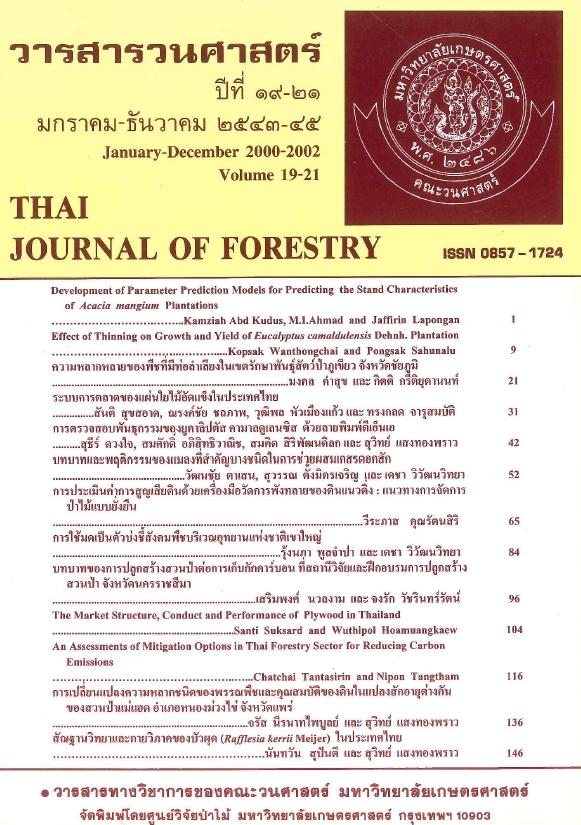ระบบการตลาดของแผ่นใยไม้อัดแข็งในประเทศไทย
Main Article Content
บทคัดย่อ
การศึกษาครั้งนี้มีวัตถุประสงค์เพื่อพิจารณาถึงการผลิต การตลาด โครงสร้างตลาด พฤติกรรมตลาดและผลการดำเนินงานตลาดของแผ่นใยไม้อัดแข็งเพื่อเป็นแนวทางในการวางแผนด้านการปลูกสร้างสวนป่าและด้านการตลาดของแผ่นใยไม้อัดแข็งในอนาคตโดยการใช้แบบสอบถามเป็นเครื่องมือในการเก็บข้อมูล จากการศึกษาพบว่า มีโรงงานไม้อัดแข็งรวม 4 โรงงาน วัตถุดิบที่ใช้ในการผลิตคือ ไม้ยูคาลิปตัส และเศษไม้ ปัญหาทางด้านการผลิตที่พบคือ คุณภาพของวัตถุดิบ ปริมาณของวัตถุดิบไม่เพียงพอในฤดูฝน เครื่องจักรเก่า ขาดแรงงานที่มีประสบการณ์ และต้นทุนการผลิตสูง ช่องทางการตลาดพบว่าจะมีการจำหน่ายแผ่นใยไม้อัดแข็งผ่านผู้ค้าปลีกบริษัทในเครือ โรงงานเฟอร์นิเจอร์ และตลาดต่างประเทศ ปัญหาทางด้านการตลาดที่พบคือ มีการแข่งขันสูงและราคาของผลิตภัณฑ์ในตลาดต่างประเทศต่ำกว่า โครงการการตลาดของแผ่นใยไม้อัดแข็งเป็นแบบผูกขาดความแตกต่างในตัวสินค้ามีไม่มากนัก ซึ่งผู้ผลิตได้เน้นไปที่การสร้างความแตกต่างด้านการให้บริการแก่ลูกค้าเพิ่มขึ้น อุปสรรคในการเข้าสู่ตลาดมีมาก เนื่องจากเป็นธุรกิจที่ใช้เงินลงทุนสูงไม่น้อยกว่า 277 ล้านบาทสำหรับโรงงานขนาดเล็ก รวมถึงอุปสรรคจากต้นทุนด้านเทคนิคการผลิต ด้านบุคลากร และอุปสรรคเนื่องจากความแตกต่างในด้านตัวสินค้าเป็นปัจจัยสำคัญที่ผู้ผลิตรายใหม่ต้องคำนึงถึง สำหรับพฤติกรรมตลาดพบว่าไม่สามารถใช้นโยบายด้านราคาได้เนื่องจากมีสินค้าในสามารถทดแทนได้และราคาขึ้นอยู่กับราคาในตลาดโลก ส่วนนโยบายด้านสินค้าจะเน้นกลยุทธ์ตราสินค้า มีการส่งเสริมการขายและรับคืนสินค้าที่ชำรุด และผลการดำเนินงานตลาดพบว่า แผ่นใยไม้อัดแข็งความหนา 3 มิลลิเมตรมีส่วนเหลื่อมการตลาดสูงสุดคือ 4,640 บาทต่อลูกบาศก์เมตร และมีค่าประสิทธิภาพการตลาดจากราคาต่ำสุดคือร้อยละ 193.06 และแผ่นใยไม้อัดความหนา 6 มิลลิเมตรมีส่วนเหลื่อมการตลาดดำสุดคือ 4,528 บาทต่อลูกบาศก์เมตร และมีค่าประสิทธิภาพการตลาดจากราคาสูงสุดคือร้อยละ 195 36 ส่วนประสิทธิภาพการตลาดทางเทคนิคพบว่าผลต่างระหว่างสัดส่วนราคาขายปลีกต่อต้นทุนการตลาดกับสัดส่วนราคาขายปลีกต่อส่วนเหลื่อมการตลาดของแผ่นใยไม้อัดแข็งมีค่าสูงมากในทุกความหนาที่ผลิตแสดงให้เห็นว่าผู้ผลิตมีโอกาสผูกขาดในการดำเนินกิจการ และกำหนดนโยบายต่างๆ ที่เกี่ยวข้องด้านการตลาด
Downloads
Article Details

อนุญาตภายใต้เงื่อนไข Creative Commons Attribution-NonCommercial-NoDerivatives 4.0 International License.
ข้าพเจ้าและผู้เขียนร่วม (ถ้ามี) ขอรับรองว่า ต้นฉบับที่เสนอมานี้ยังไม่เคยได้รับการตีพิมพ์และไม่ได้อยู่ในระหว่างกระบวนการพิจารณาตีพิมพ์ลงในวารสารหรือสิ่งตีพิมพ์อื่นใด ข้าพเจ้าและผู้เขียนร่วม (ถ้ามี) ยอมรับหลักเกณฑ์และเงื่อนไขการพิจารณาต้นฉบับ ทั้งยินยอมให้กองบรรณาธิการมีสิทธิ์พิจารณาและตรวจแก้ต้นฉบับได้ตามที่เห็นสมควร พร้อมนี้ขอมอบลิขสิทธิ์ผลงานที่ได้รับการตีพิมพ์ให้แก่วารสารวนศาสตร์ คณะวนศาสตร์ มหาวิทยาลัยเกษตรศาสตร์ กรณีมีการฟ้องร้องเรื่องการละเมิดลิขสิทธิ์เกี่ยวกับภาพ กราฟ ข้อความส่วนใดส่วนหนึ่ง หรือ ข้อคิดเห็นที่ปรากฏในผลงาน ให้เป็นความรับผิดชอบของข้าพเจ้าและผู้เขียนร่วม (ถ้ามี) แต่เพียงฝ่ายเดียว และหากข้าพเจ้าและผู้เขียนร่วม (ถ้ามี) ประสงค์ถอนบทความในระหว่างกระบวนการพิจารณาของทางวารสาร ข้าพเจ้าและผู้เขียนร่วม (ถ้ามี) ยินดีรับผิดชอบค่าใช้จ่ายทั้งหมดที่เกิดขึ้นในกระบวนการพิจารณาบทความนั้น”


